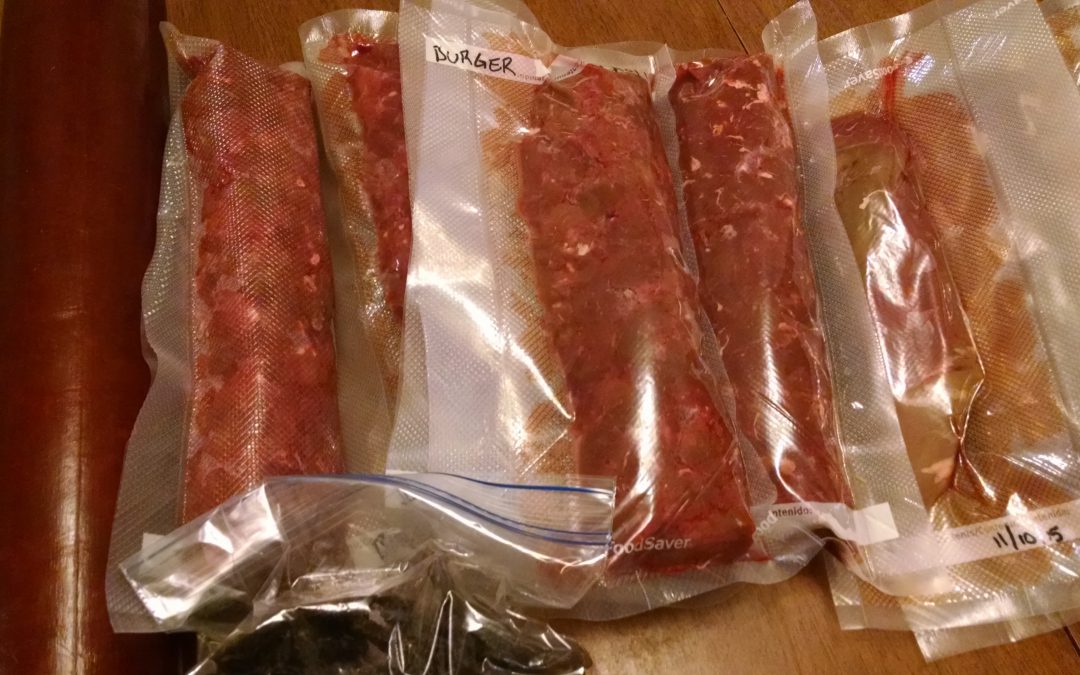
by Jennifer Bearden | Jul 8, 2022
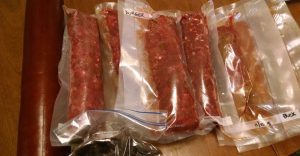
Further Processed Venison
Photo Credit: Jennifer Bearden
I often get questions about eating wild game by new hunters. Questions like: Is it safe to eat? How do you process it? How nutritious is it for my family? Does it taste good? A group of agents and specialists joined forces and created 4 new publications to answer these questions and more.
Publication #1
WILD GAME: SAFETY AND QUALITY IN THE FIELD
This publication starts with safety during the hunt. It then talks about skinning the deer and getting the meat to below 40°F as quickly as possible. It also warns hunters about zoonotic diseases and how to protect from diseases such as tuberculosis, brucellosis, and leptospirosis.
Publication #2
WILD GAME: FRESH MEAT PROCESSING
This publication talks about aging of meats, carcass cutting, grinding, storing, freezing and thawing. The ultimate goal is safe and tasty wild game meat in the forms that you and your family personally enjoy.
Publication #3
WILD GAME: FURTHER PROCESSING OF WILD GAME MEAT
This publication focuses on food safety when making items such as sausage, jerky and other cured meats.
Publication #4
WILD GAME: FOOD SAFETY AND NUTRITION
This publication emphasizes food safety concerns such as storage temperatures, minimum internal temperatures when cooking, thawing frozen meats properly. It also outlines how nutritious wild game meat can be.
Do you want to get into hunting and enjoying this safe, delicious, and nutritious food supply? We welcome new hunters! For Florida residents, check myFWC.com for residency qualifications, exemptions, and hunter safety requirements.
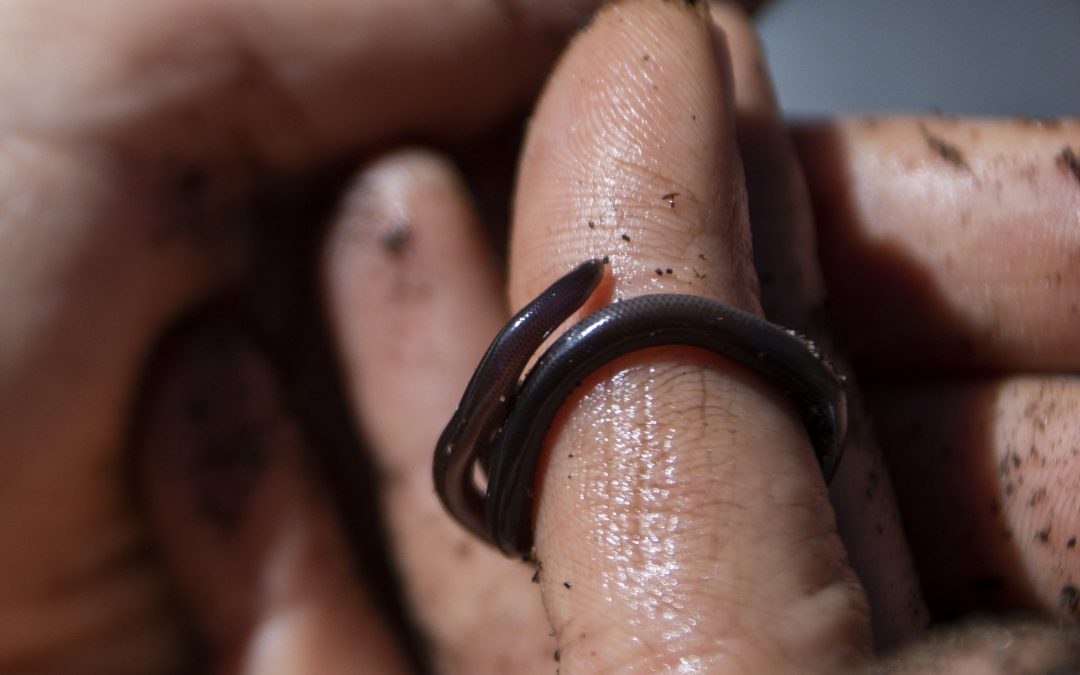
by Scott Jackson | May 26, 2022
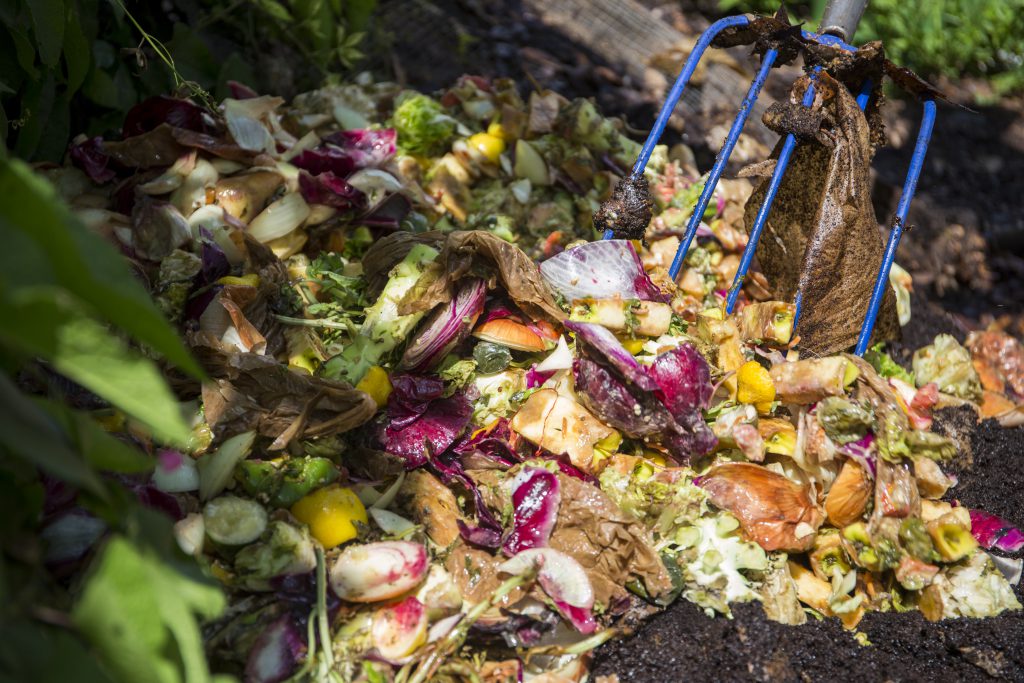
Nutrients found in food waste are too valuable to just toss away. Small scale composting and vermicomposting provide opportunity to recycle food waste even in limited spaces. UF/IFAS Photo by Camila Guillen.
During the summer season, my house is filled with family and friends visiting on vacation or just hanging out on the weekends. The kitchen is a popular place while waiting on the next outdoor adventure. I enjoy working together to cook meals, bbq, or just make a few snacks. Despite the increased numbers of visitors during this time, some food is leftover and ultimately tossed away as waste. Food waste occurs every day in our homes, restaurants, and grocery stores and not just this time of year.
The United States Food and Drug Administration estimates that 30 to 40 percent of our food supply is wasted each year. The United States Department of Agriculture cites food waste as the largest type of solid waste at our landfills. This is a complex problem representing many issues that require our attention to be corrected. Moving food to those in need is the largest challenge being addressed by multiple agencies, companies, and local community action groups. Learn more about the Food Waste Alliance at https://foodwastealliance.org
According to the program website, the Food Waste Alliance has three major goals to help address food waste:
Goal #1 REDUCE THE AMOUNT OF FOOD WASTE GENERATED. An estimated 25-40% of food grown, processed, and transported in the U.S. will never be consumed.
Goal #2 DONATE MORE SAFE, NUTRITIOUS FOOD TO PEOPLE IN NEED. Some generated food waste is safe to eat and can be donated to food banks and anti-hunger organizations, providing nutrition to those in need.
Goal #3 RECYCLE UNAVOIDABLE FOOD WASTE, DIVERTING IT FROM LANDFILLS. For food waste, a landfill is the end of the line; but when composted, it can be recycled into soil or energy.
All these priorities are equally important and necessary to completely address our country’s food waste issues. However, goal three is where I would like to give some tips and insight. Composting food waste holds the promise of supplying recycled nutrients that can be used to grow new crops of food or for enhancing growth of ornamental plants. Composting occurs at different scales ranging from a few pounds to tons. All types of composting whether big or small are meaningful in addressing food waste issues and providing value to homeowners and farmers. A specialized type of composting known as vermicomposting uses red wiggler worms to accelerate the breakdown of vegetable and fruit waste into valuable soil amendments and liquid fertilizer. These products can be safely used in home gardens and landscapes, and on house plants.
Composting meat or animal waste is not recommended for home composting operations as it can potentially introduce sources of food borne illness into the fertilizer and the plants where it is used. Vegetable and Fruit wastes are perfect for composting and do not have these problems.
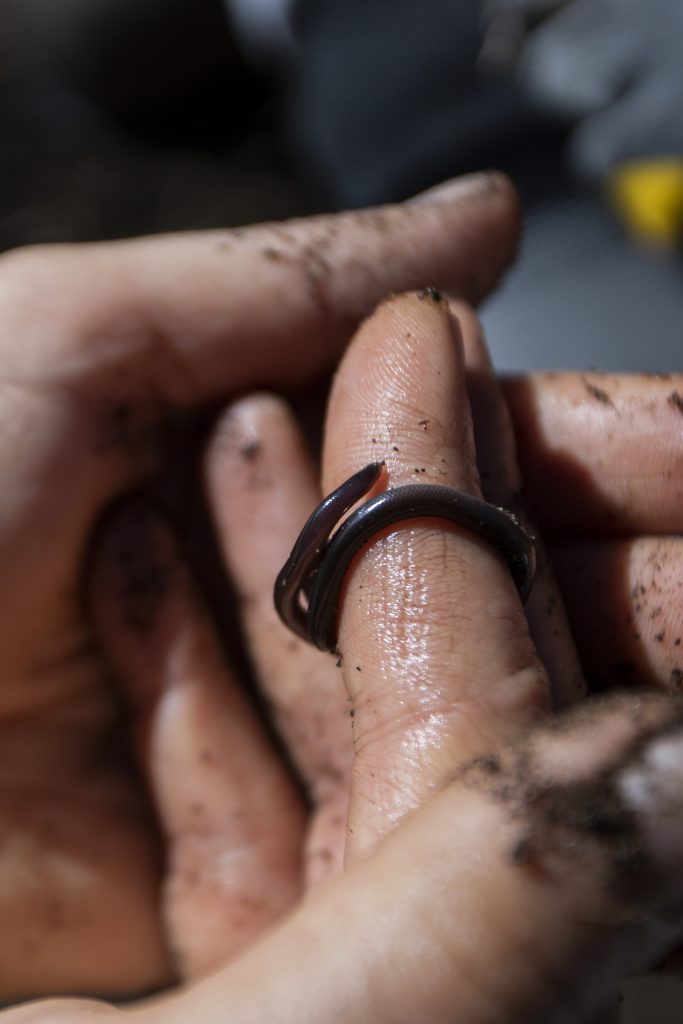
Composting worms help turn food waste into valuable fertilizer. UF/IFAS Photo by Tyler Jones
Detailed articles on how vermicomposting works are provided by Tia Silvasy, UF/IFAS Extension Orange County at https://blogs.ifas.ufl.edu/orangeco/2020/12/10/vermicomposting-using-worms-for-composting and https://sfyl.ifas.ufl.edu/media/sfylifasufledu/orange/hort-res/docs/pdf/021-Vermicomposting—Cheap-and-Easy-Worm-Bin.pdf Supplies are readily available and relatively inexpensive. Please see the above links for details.
A small vermicomposting system would include:
• Red Wiggler worms (local vendors or internet)
• Two Plastic Storage Bins (approximately 30” L x 20” W x 17” H) with pieces of brick or stone
• Shredded Paper (newspaper or other suitable material)
• Vegetable and Fruit Scraps
Red Wiggler worms specialize in breaking down food scraps unlike earthworms which process organic matter in soil. Getting the correct worms for vermicomposting is an important step. Red Wigglers can consume as much as their weight in one day! Beginning with a small scale of 1 to 2 pounds of worms is a great way to start. Sources and suppliers can be readily located on the internet.
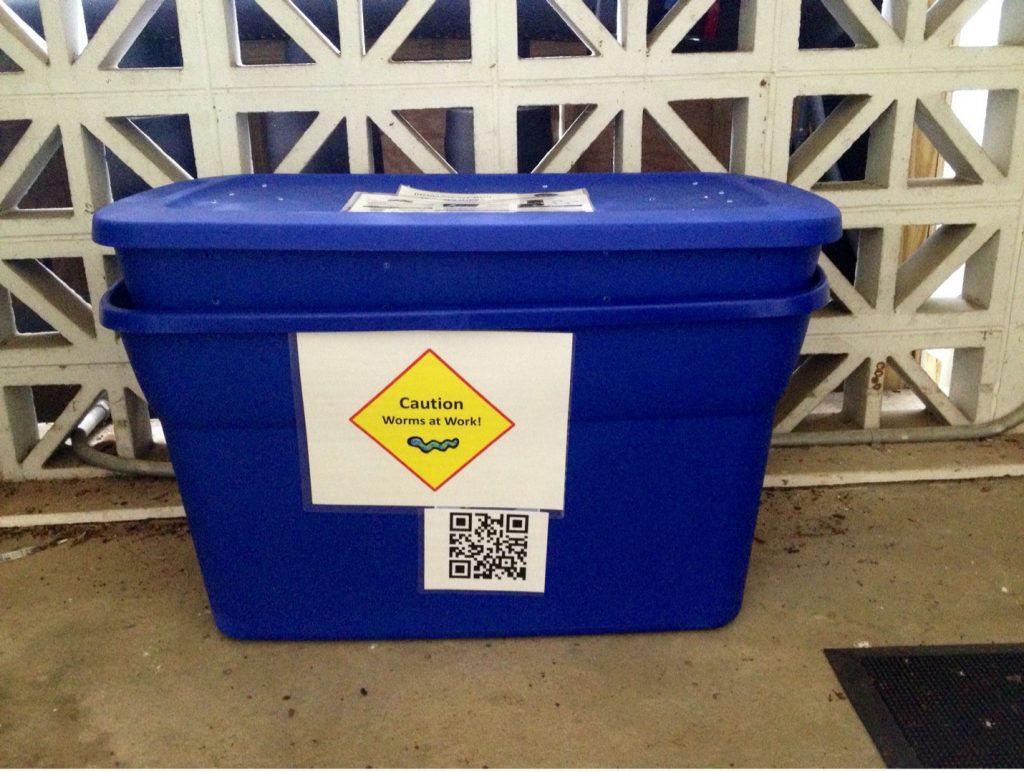
Worm “homes” can be constructed from two plastic storage bins with air holes drilled on the top. Additional holes put in the bottom of the inner bin to drain liquid nutrients. Pieces of stone or brick can be used to raise the inner bin slightly. Picture provided by UF/IFAS Extension Leon County, Molly Jameson
Once the worms and shredded paper media have been introduced into the bins, you are ready to process kitchen scraps and other plant-based leftovers. Food waste can be placed in the worm bins by moving along the bin in sections. Simply rotate the area where the next group of scraps are placed. See example diagram. For additional information or questions please contact our office at 850-784-6105.

Placing food scraps in a sequential order allows worms to find their new food easily. Contributed diagram by L. Scott Jackson
Portions of this article originally published in the Panama City News Herald
UF/IFAS is An Equal Opportunity Institution.
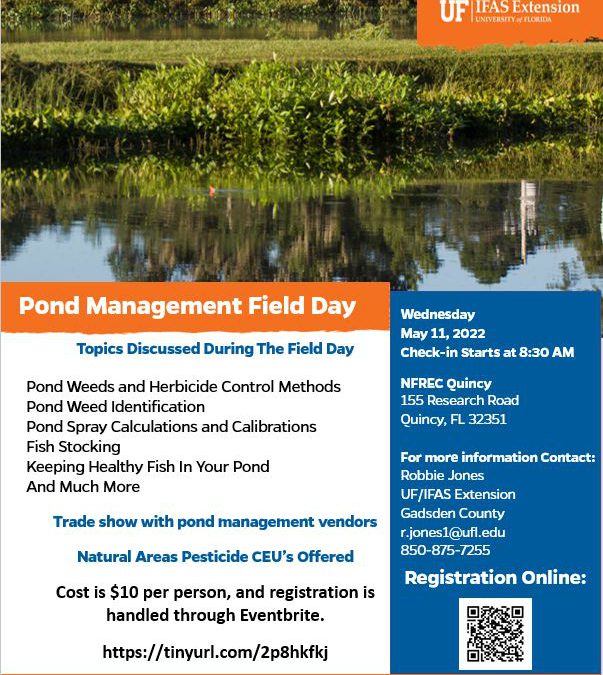
by Ray Bodrey | Apr 25, 2022
A Pond Management Field Day will be held May 11, 2022, at the North Florida Research and Education Center, in Quincy, Florida. The field day will include pond demonstrations and classroom workshops on weed prevention, sprayer calibrations, and fish stocking and management. There will also be a trade show with vendors as well as pond water testing and weed identification. The field day will also provide Pesticide CEU’s for natural areas. Registration for the Field Day is through Eventbrite and the cost for the day is $10, which includes lunch. For questions or more information, contact Robbie Jones at the UF/FAS Extension- Gadsden County Office – 850-875-7255.
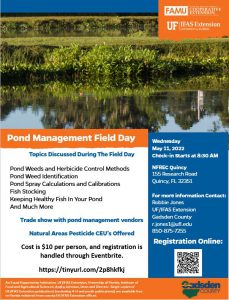
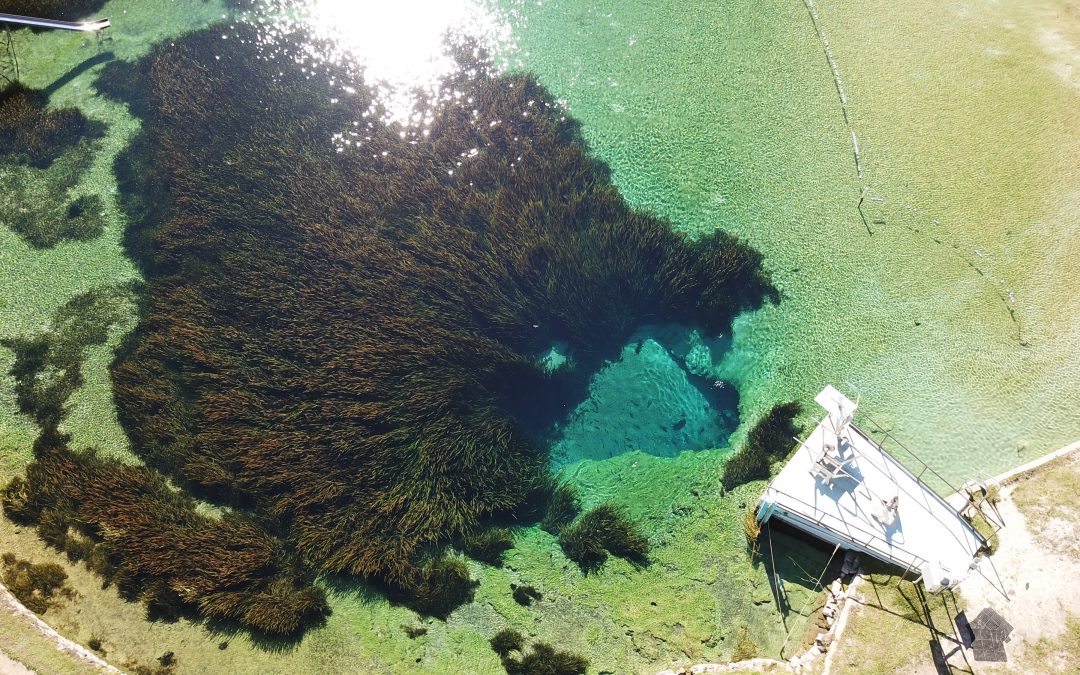
by Andrea Albertin | Jan 20, 2022

Jackson Blue Springs discharging from the Floridan Aquifer. Jackson County, FL. Image: Doug Mayo, UF/IFAS Extension.
Florida has one of the largest concentrations of freshwater springs in the world. More than 1000 have been identified statewide, and here in the Florida Panhandle, more than 250 have been found. Not only are they an important source of potable water, springs have enormous recreational and cultural value in our state. There is nothing like taking a cool swim in the crystal-clear waters of these unique, beautiful systems.
How do springs form?
We have so many springs in Florida because of the state’s geology. Florida is underlain by thick layers of limestone (calcium carbonate) and dolomite (calcium magnesium carbonate) that are easily dissolved by rainwater that percolates into the ground. Rainwater is naturally slightly acidic (with a pH of about 5 to 5.6), and as it moves through the limestone and dolomite, it dissolves the rock and forms fissures, conduits, and caves that can store water. In areas where the limestone is close to the surface, sinkholes and springs are common. Springs form when groundwater that is under pressure flows out through natural openings in the ground. Most of our springs are found in North and North-Central Florida, where the limestone and dolomite are found closest to the surface.
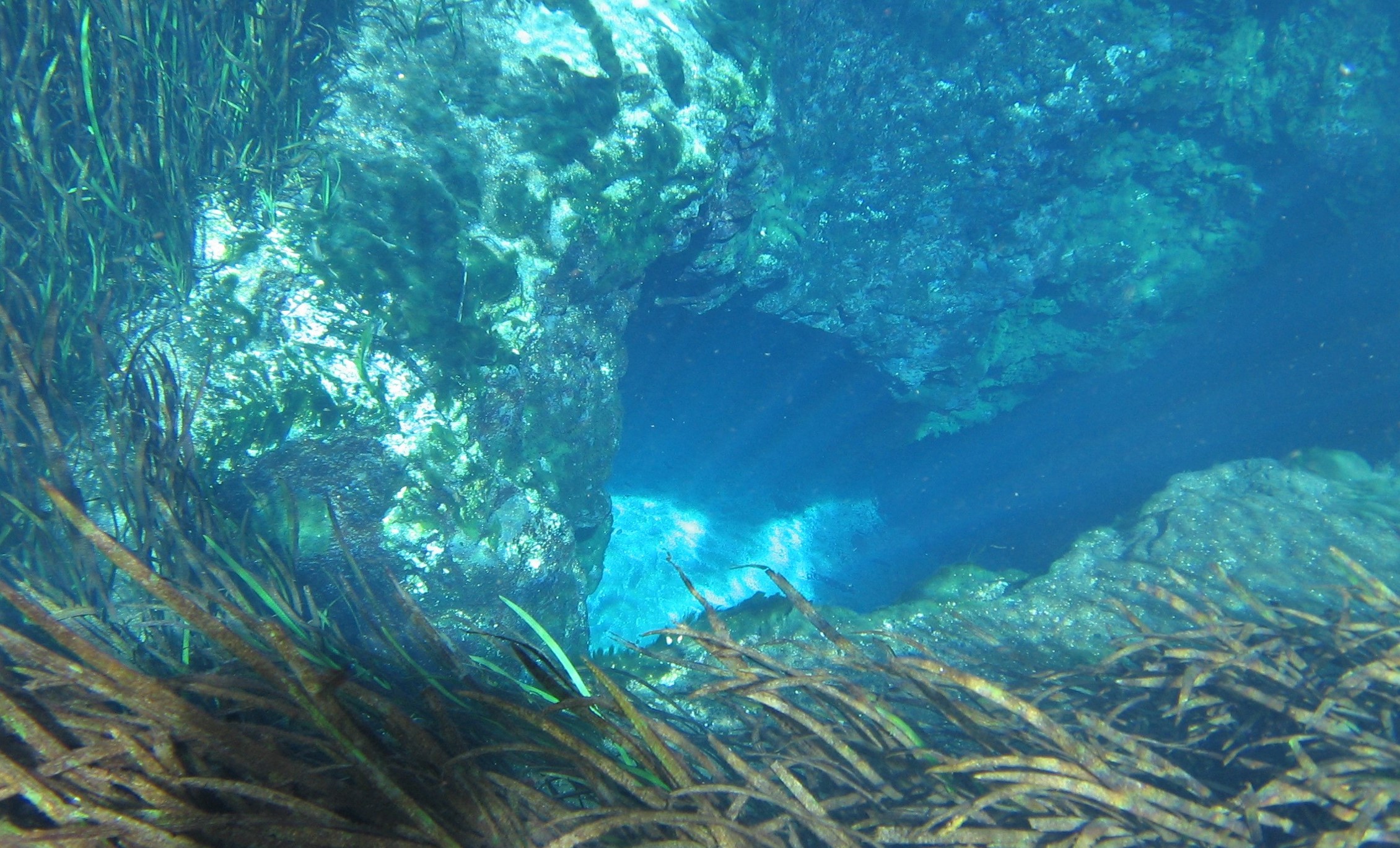
Springs are windows to the Floridan Aquifer, which supplies most of Florida’s drinking water. Image: Ichetucknee Blue Hole, A. Albertin.
These thick layers of limestone and dolomite that are below us, with pores, fissures, conduits, and caves that store water, make up the Floridan Aquifer. The Floridan Aquifer includes all of Florida and parts of Georgia, South Carolina, and Alabama. The thickness of the aquifer varies widely, ranging from 250 ft. thick in parts of Georgia, to about 3,000 ft. thick in South Florida. The Floridan is one of the most productive aquifer systems in the world. It provides drinking water to about 11 million Floridians and is recharged by rainfall.
How are springs classified?
Springs are commonly classified by their discharge or flow rate, which is measured in cubic feet or cubic meters per second. First magnitude springs have a flow rate of 100 cubic feet or more per second, 2nd magnitude springs have a rate of 10-100 ft.3/sec., 3rd magnitude flows are 1-10 ft.3/sec. and so on. We have 33 first magnitude springs in the state, and the majority of these are found in state parks. These springs pump out massive amounts of water. A flow rate of 100 ft.3/sec. translates to 65 million gallons per day. Larger springs in Florida supply the base flow for many streams and rivers.
What affects spring flow?
Multiple factors can affect the amount of water that flows from springs. These include the amount of rainfall, size of caverns and conduits that the water is flowing through, water pressure in the aquifer, and the size of the spring’s recharge basin. A recharge basin is the land area that contributes water to the spring – surface water and rainwater that falls on this area can seep into the ground and end up as part of the spring’s discharge. Drought and activities such as groundwater withdrawals through pumping can reduce flow from springs systems.
If you haven’t experienced the beauty of a Florida Spring, there is really nothing quite like it. Here in the panhandle, springs such as Wakulla, Jackson Blue, Pitt, Williford, Morrison, Ponce de Leon, Vortex, and Cypress Springs are some of the areas that offer wonderful recreational opportunities. The Florida Department of Environmental Protection has a ‘springs finder’ web page with an interactive map that can help you locate these and many other springs throughout the state.
https://nwdistrict.ifas.ufl.edu/nat/2020/04/09/the-incredible-floridan-aquifer/

by Daniel J. Leonard | Oct 7, 2021
Fall is the absolute best season for wildflower watching in the Panhandle! When mid-September rolls around and the long dog days of summer finally shorten, giving way to drier air and cooler nights, northwest Florida experiences a wildflower color explosion. From the brilliant yellow of Swamp Sunflower and Goldenrod, to the soothing blue of Mistflower, and the white-on-gold of Spanish Needles, there is no shortage of sights to see from now until frost. But, in my opinion, the stars of the fall show are the currently flowering, beautiful pink blooms of False Foxglove (Agalinus spp.).
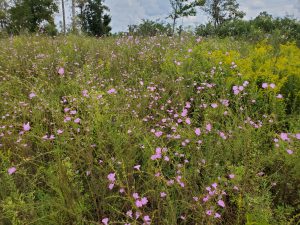
False Foxglove in a Calhoun County natural area. Photo courtesy of Daniel Leonard.
Named for the appearance of their flowers, which bear a resemblance to the northern favorite Foxglove (Digitalis spp.), “False Foxglove” is actually the common name of several closely related species of parasitic plants in the genus Agalinus that are difficult to distinguish by all but the keenest of botanists. Regardless of which species you may see, False Foxglove is an unusual and important Florida native plant. Emerging from seed each spring in the Panhandle, plants grow quickly through the summer to a mature height of 3-5’. During this time, False Foxglove is about as inconspicuous a plant as grows. Consisting of a wispy thin stem with very small, narrow leaves, plants remain hidden in the flatwoods and sand hill landscapes that they inhabit. However, when those aforementioned shorter September days arrive, False Foxglove explodes into flower sporting sprays of dozens of light purple to pink tubular-shaped flowers that remain until frost ends the season.
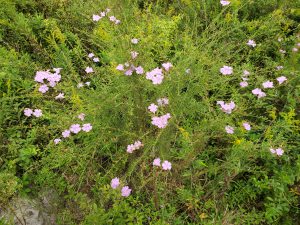
False Foxglove flowering in a Calhoun County natural area. Photo courtesy of Daniel Leonard.
In addition to being unmatched in flower, False Foxglove also plays several important ecological roles in Florida’s natural areas. First, False Foxglove’s relatively large, tubular-shaped flowers are the preferred nectar sources for the larger-sized native solitary and bumble bees present in the Panhandle, though all manner of generalist bees and butterflies will also visit for a quick sip. Second, False Foxglove is the primary host plant for the unique Common Buckeye butterfly. One of the most easily recognizable butterflies due to the large “eye” spots on their wings, Common Buckeye larvae (caterpillars), feed on False Foxglove foliage during the summer before emerging as adults and adding to the fall spectacle. Finally, False Foxglove is an important indicator of a healthy native ecosystem. As a parasitic plant, False Foxglove obtains nutrients and energy by photosynthesis AND by using specialized roots to tap into the roots of nearby suitable hosts (native grasses and other plants). As both False Foxglove and its parasitic host plants prefer to grow in the sunny, fire-exposed areas pine flatwoods and sand ridges that characterized pre-settlement Florida, you can be fairly confident that if you see a natural area with an abundance of False Foxglove in flower, that spot is in good ecological shape!
The Florida Panhandle is nearly unmatched in its fall wildflower diversity and False Foxglove plays a critical part in the show. From its stunning flowers to its important ecological roles, one would be hard-pressed to find a more unique native wildflower! For more information about False Foxglove and other Florida native wildflowers, contact us at the UF/IFAS Calhoun County Extension office.
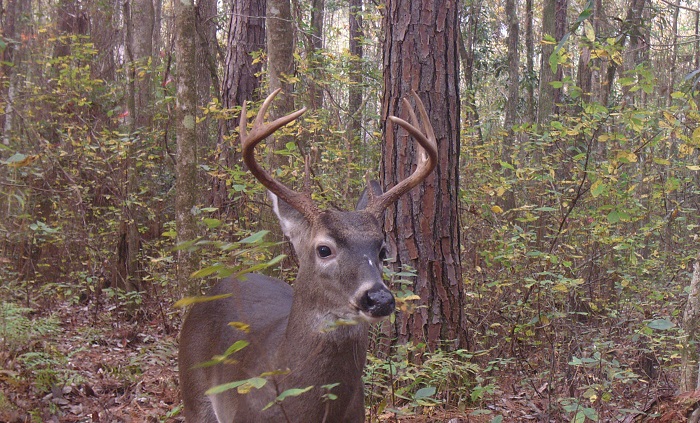
by Mark Mauldin | Apr 9, 2021
Spring can be a busy time of year for those of us who are interested in improving wildlife habitat on the property we own/manage. Spring is when we start many efforts that will pay-off in the fall. If you are a weekend warrior land manager like me there is always more to do than there are available Saturdays to get it done. The following comments are simple reminders about some habitat management activities that should be moving to the top of your to-do list this time of year.
Aquatic Weed Management – If you had problematic weeds in you pond last summer, chances are you will have them again this summer. NOW (spring) is the time to start controlling aquatic weeds. The later into the summer you wait the worse the weeds will get and the more difficult they will be to control. The risk of a fish-kill associated with aquatic weed control also increases as water temperatures and the total biomass of the weeds go up. Springtime is “Just Right” for Using Aquatic Herbicides
Cogongrass Control – Spring is actually the second-best time of year to treat cogongrass, fall (late September until first frost) is the BEST time. That said, ideally cogongrass will be treated with herbicide every six months, making spring and fall important. When treating spring regrowth make sure that there are green leaves at least one foot long before spraying. Spring is also an excellent time of year to identify cogongrass patches – the cottony, white blooms are easy to spot. Identify Cogongrass Now – Look for the Seedheads; Cogongrass – Now is the Best Time to Start Control
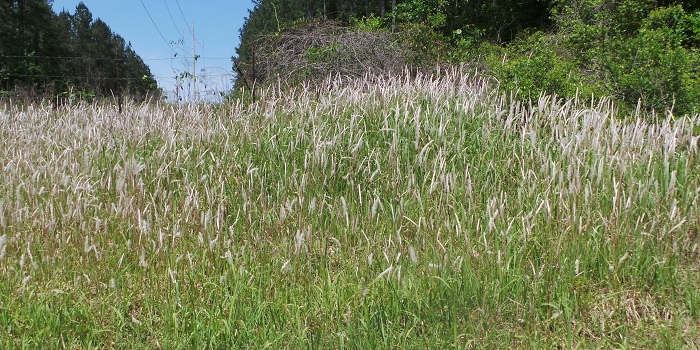
Cogongrass seedheads are easily spotted this time of year.
Photo credit: Mark Mauldin
Warm-Season Food Pots – There is a great deal of variation in when warm season food plots can be planted. Assuming warm-season plots will be panted in the same areas as cool-season plots, the simplest timing strategy is to simply wait for the cool-season plots to play out (a warm, dry May is normally the end of even the best cool-season plot) and then begin preparation for the warm-season plots. This transition period is the best time to deal with soil pH issues (get a soil test) and control weeds. Seed for many varieties of warm-season legumes (which should be the bulk of your plantings) can be somewhat hard to find, so start looking now. If you start early you can find what you want, and not just take whatever the feed store has. Warm Season Food Plots for White-tailed Deer
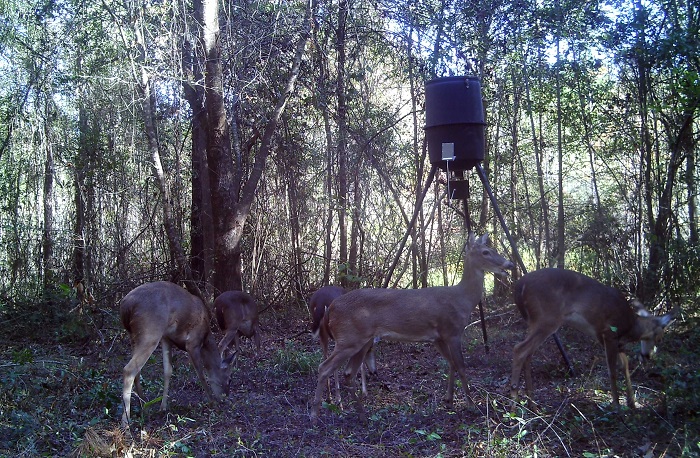
Deer Feeders – Per FWC regulations deer feeders need to be in continual operation for at least six months prior to hunting over them. Archery season in the Panhandle will start in mid-October, meaning deer feeders need to be up and running by mid-April to be legal to hunt opening morning. If you have plans to move or add feeders to your property, you’d better get to it pretty soon. FWC Feeding Game
Dove Fields – The first phase of dove season will begin in late September. When you look at the “days to maturity” for the various crops in the chart below you might feel like you’ve got plenty of time. While that may be true, don’t forget that not only do you need time for the crop to mature, but also for seeds to begin to drop and birds to find them all before the first phase begins. Because doves are particularly fond of feeding on clean ground, controlling weeds is a worthwhile endeavor. If you are planting on “new ground”, applying a non-selective herbicide several weeks before you begin tillage is an important first step to a clean field, but it adds more time to the process. As mentioned above, it’s always pertinent to start sourcing seed well in advance of your desired planting date. Timing is Crucial for Successful Dove Fields
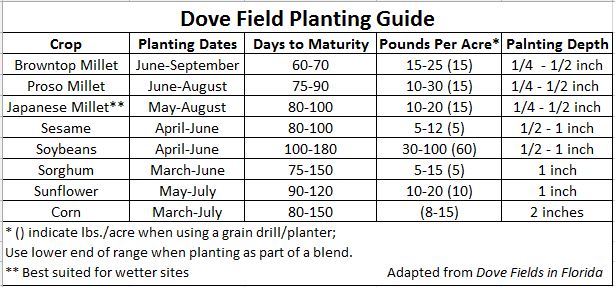
There are many other projects that may be more time sensitive than the ones listed above. These were just a few that have snuck up on me over the years. The links in each section will provide more detailed information on the topics. If you have questions about anything addressed in the article feel free to contact me or your county’s UF/IFAS Extension Natural Resource Agent.



















